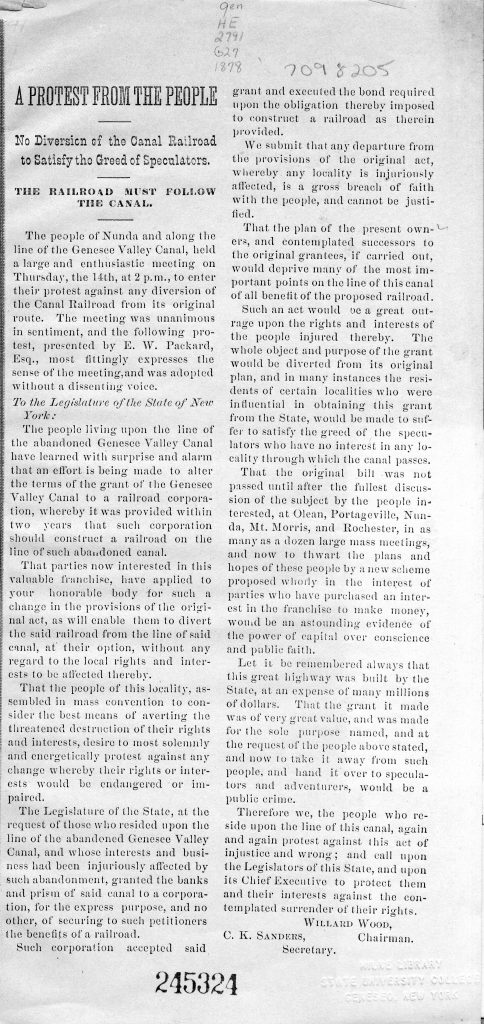It is hard to tell the tale of this thin line of land without addressing the economics which shaped much of the history of the landscape. The canal and railroad all had their beginnings and demises brought upon by, at the core, economics and the constant tumultuous game of profit and loss.
The canal was advertised to bring great prosperity to the towns that it passed through, and many people anticipated that it would do just that. The poem to the left was sung at a celebration for the opening of the Genesee Valley Canal in Nunda, NY. The poet A.M. Crane writes, “And Allegany’s prime clad plains / Are destined to become / The poor man’s surest source of gain / And build the rich man’s home”(Hand). These hopes echoed in the poem paint the canal to be something which will bring enormous economic prosperity and therefore, immense joy to the region. However, looking at the graph below, it is obvious that though the canal did have a brief heyday, the short-lived nature of this canal was not in fact able to “build the rich man’s home.”
The graph and chart below paint a picture of the canal’s eventual decline in terms of dollar value of property transported on the Genesee Valley Canal.
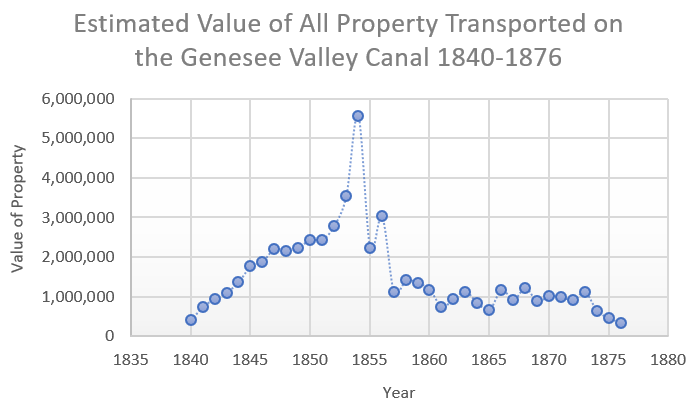
Fig 2. Graph based on data used from Documents Accompanying the Auditor’s Report.
After a brief thirty or so years of upswing, the canal fell out of use, often due to continued maintenance issues. The Livingston Republican wrote about the Genesee Valley canal:
“The tables show that this has been the most expensive of any of the lateral canals. The amendment of 1847 prohibited the sale or lease of any of the canals, but this one adopted last year removes this restriction and allows them to be sold. They have become almost useless by reason of the multiplication of railroads in every direction. After the present year they will be abandoned except the Black River, which is required to feed the Erie with water. The state treasury will feel the benefit of the abandonment.”
This amendment then put into effect the amendment which would lead to the sale of this canal and creation of the Genesee Valley Canal Railroad. With the state treasury feeling the benefit of the abandonment, it was evident that others did not feel the same benefits, especially those living along the canal were frightened at the prospect of losing both their route to the outside world and their source of income. Many people protested this abandonment of the route and urged their town to stay on the map, believing that they had a right to the economic benefits that this route held. In the article, they write: “Let it be remembered always that this great highway was built by the State, at an expense of many millions of dollars. That the grant it made was of very great value, and was made for the sole purpose named, and at the request of the people above stated, and now to take it away from such people, and hand it over to speculators and adventurers, would be a public crime.” You can further explore one of their arguments by clicking on the article to the right.
Eventually though the railroad was built, and from its initial building was continually passed around from one company to another. In 1963, though, the now Rochester branch of the Pennsylvania Railroad was also abandoned. Even the Greenway, which one would not think had its origins in economics, giving it being a volunteer-based, no charge organization, states that one of its goals is to “stimulate economic development through promotion of tourism and Greenway trail-related businesses” (“Major Goals”).
With all of these grand hopes of economic prosperity envisioned and immense landscape changes undertaken with the goal of bringing wealth to the area, it is still surprising to walk through these small rural towns, with many people still below the poverty line in lieu of all these efforts. Does this landscape tell the tale of the failure of the American dream and all its ambitious enterprises or does it simply present an opportunity to rebuild and restart with a different focus?
When exploring and thinking about these ideals, I headed to the rural town of Mount Morris, NY. According to Data USA, Mount Morris has a population of 2,505 with a median household income of $36,875 with 21.4% of people below the poverty line, which is significantly more than the nation’s overall 14.7% below the poverty line. The first time I ever walked on the Genesee Valley Greenway was when I walked through the section in the town of Mount Morris, and when I first set off on the trail, I was a little taken aback and it became immediately difficult for me to reconcile this place with the nature trail that I was anticipating.

My senses were immediately hypercritical of the place, as they picked up on the old beer cans and fast food wrappers mingled in with the trees and the sound of a nail gun intermingled with a distant bird call. The trail wound itself right through the edge of town, passing in close contact with the backyards of homes, war memorials, bowling alleys and laundromats. At some points, the houses were so close to the trail that I had a lingering feeling I was trespassing, as I walked past mobile homes and easily peered into the small and cluttered kitchens. At one point along the trail, large concrete foundations of an old home sat on the side of the path, and I thought about whether the building of this trail uprooted these people from their home, in an ironic human-induced version of “nature’s” take-back of civilization.
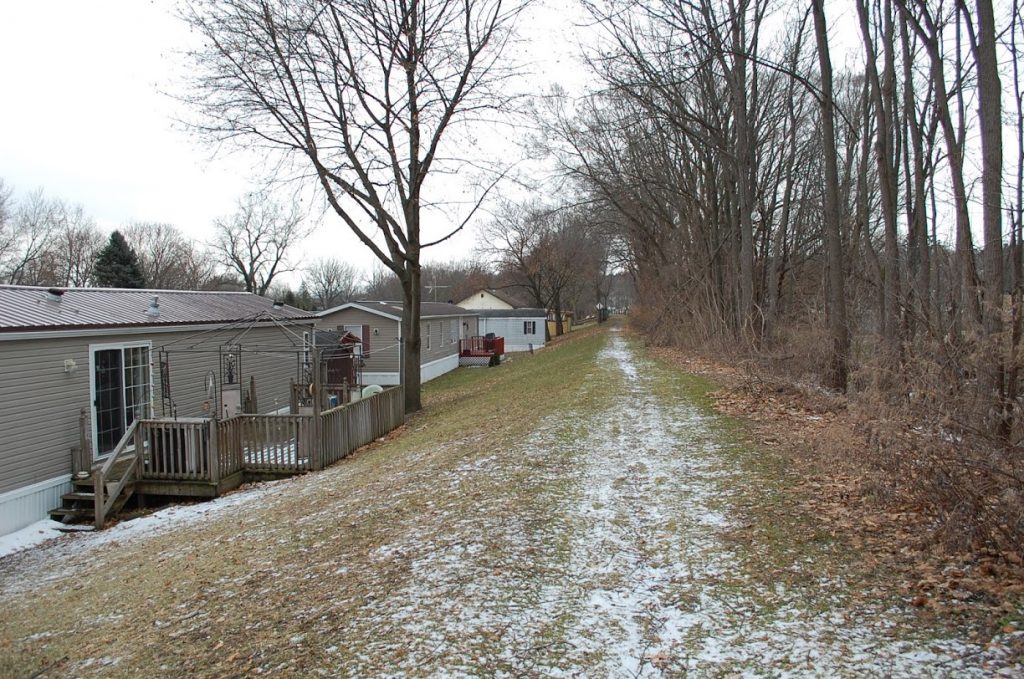
I imagined this place in the spring, when the sun would shine through the full, green trees, blotting out the nearby street and the small, rural poverty that ran alongside it, and I imagined that this trail could present some kind of elusive escape from its immediate surroundings, but today with the bleak gray February skies and the bare trees, the harsh reality of the trail’s surroundings really challenged me to not see the failure of this American dream represented among in this trail. I wanted to see this trail as an opportunity to reconcile economic stimulation and environmental appreciation, but it was difficult for me to do just that in this particular area where the property value was low and the environmental designation of the trail was simply used as a drop-off zone for cigarette butts, beer cans and old couches.
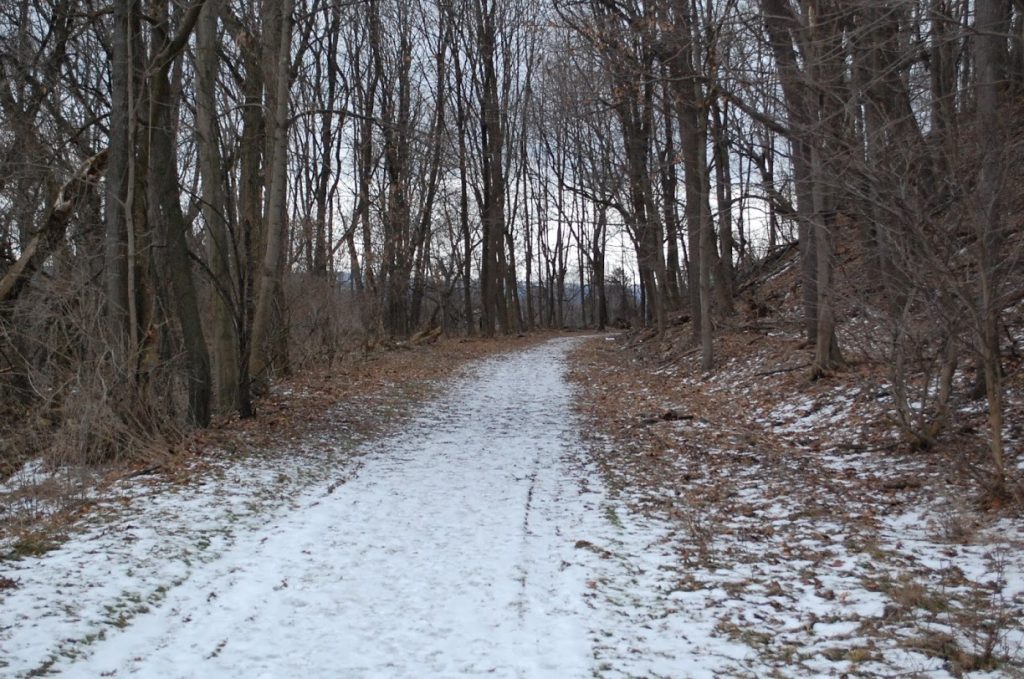
However, walking further in the opposite direction of the town, I came across Mount Morris County Park, and as I walked from one place to the other, the town gradually faded away and suddenly it seemed, I was in “nature.” The trail isolated itself from the nearby town with a steep hill covered in fallen leaves and trees on one side and farmland on the other side. I heard the sounds of water dripping off trees and cardinals overhead, and it was a refreshing change. These two places, less than a mile away, were extremely diverse, yet this trail served as a connector between them. The economics of the place seemed to fade from view as I entered this park, and I started to look at this trail as an opportunity for a new beginning, not only for the places it ran through, but for a more symbolic perspective and priority shift of society as a whole.
Perhaps, this new trail would not bring immense economic stimulation that the canal, railroad, and even the trail itself once desired, but it could offer an escape from these issues, it could offer a place of solace that encourages one to get outside and take in not only the views of the park, but the views of the surrounding town too, in order to connect, engage and improve these places. It could be a place that encourages one to find nature in far-reaching places and perhaps reconcile the diversity of the trail’s path by shifting perspectives of nature and priorities of society. Maybe in the twenty-first century, we can create nature paths without necessitating economic gain, but instead encourage a more everlasting gain in overall well-being by connecting people deeper to the places that they run through.
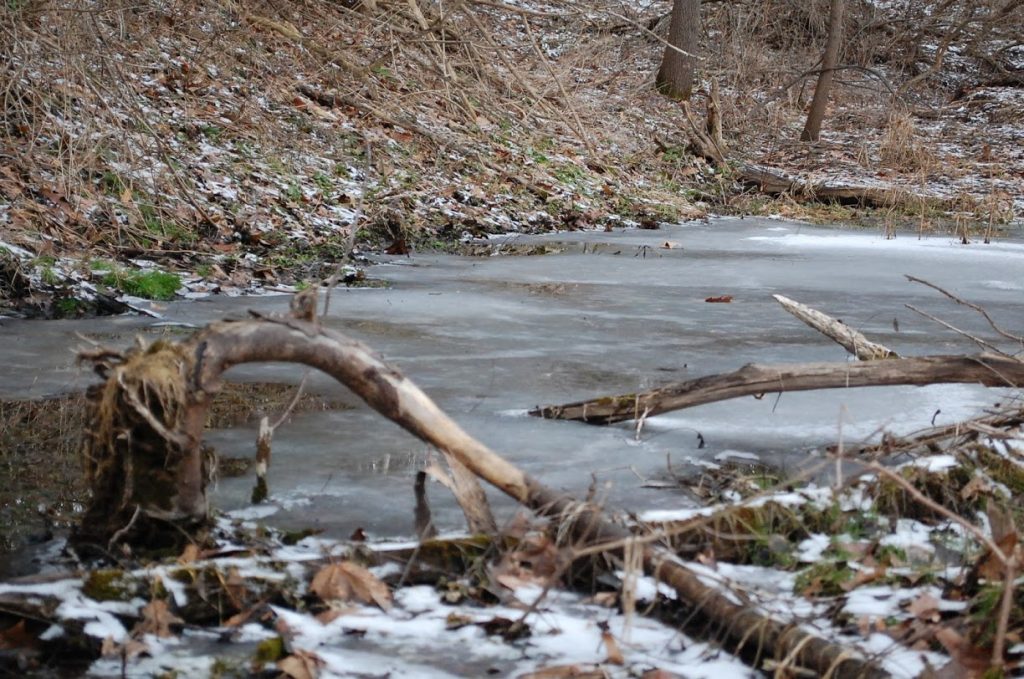
Sources:
Livingston Republican [Geneseo, NY]. 25 January 1877. Pg. 2.
“Major Goals.” Friends of the Genesee Greenway, http://fogvg.org/major-goals/. Accessed 14 April 2018.
“Mount Morris, NY.” Data USA, https://datausa.io/profile/geo/mount-morris-ny/. Accessed 14 April 2018.
Images:
Fig 1. Hand, Henry Wells. Centennial History of the Town of Nunda. Nunda, Rochester Herald Press, 1908.
Fig 2. Documents Accompanying the Auditor’s Report. State of New York, 1877.
Fig 3. Wood, Willard. “A Protest from the People.” 1878.

